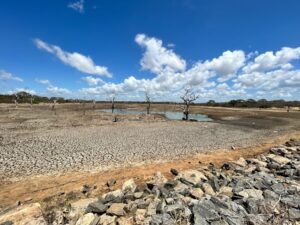Physical Address
23,24,25 & 26, 2nd Floor, Software Technology Park India, Opp: Garware Stadium,MIDC, Chikalthana, Aurangabad, Maharashtra – 431001 India
Physical Address
23,24,25 & 26, 2nd Floor, Software Technology Park India, Opp: Garware Stadium,MIDC, Chikalthana, Aurangabad, Maharashtra – 431001 India

Drought is no longer a distant threat confined to arid regions; it is a global crisis fueled by climate change, unsustainable water practices, and land degradation. The ripple effects of prolonged drought extend beyond water scarcity, impacting food security, ecosystems, and economies worldwide. According to the 2024 Drought Atlas by the United Nations Convention to Combat Desertification (UNCCD), by 2050, three out of every four people on Earth could face the devastating impacts of drought.
The Drought Crisis: A Global Wake-Up Call
The 2024 Drought Atlas paints a stark picture of a world increasingly gripped by drought. The report highlights that climate change is intensifying the frequency and severity of droughts, making previously water-secure regions vulnerable. Sub-Saharan Africa, South Asia, and Latin America already bear the brunt of prolonged dry spells, with cascading effects on agriculture, livelihoods, and public health.
Dr. N. Subash Pillai, Head & Principal Scientist, Division of Agricultural Physics, ICAR, while interacting with CFC India, emphasised the pivotal role of climate change in exacerbating droughts in India. He stated, “Rising temperatures intensify evaporation rates, leading to faster soil moisture and water bodies depletion. Shifts in monsoon patterns, driven by climate change, result in delayed, erratic, or deficient rainfall, amplifying drought risks in regions like Maharashtra, Rajasthan, and Tamil Nadu. The increasing frequency of El Niño events, influenced by global warming, further disrupts India’s rainfall distribution.” He also stressed that these climatic changes severely impact agriculture, livelihoods, and water security, with small and marginal farmers being the most vulnerable.
Population growth and unsustainable water use compound the issue. Global water demand has risen sixfold over the past century, with agriculture accounting for 70% of freshwater use. Deforestation and land degradation further exacerbate the crisis by reducing the land’s ability to retain moisture. Recurring droughts could push millions into extreme poverty and food insecurity without urgent interventions.
Insights from the Drought Atlas
The UNCCD’s 2024 Drought Atlas is more than a warning; it provides a roadmap for resilience. The report emphasises that proactive measures can significantly mitigate the impacts of drought. Among the key recommendations are adopting sustainable water management practices and developing early-warning systems that use advanced data modelling to predict drought conditions.
Dr Pillai also highlighted the need for global climate policies to integrate region-specific needs, stating, “To address these challenges, international agreements like the Paris Accord should prioritise technology transfer and financial support to enable India’s transition to sustainable water and land management practices. Domestic adaptation measures, such as promoting drought-resistant crops, enhancing rainwater harvesting systems, and implementing early warning systems, are critical.” He further noted the importance of strengthening programs like MGNREGA for drought mitigation and improving irrigation efficiency, emphasising a combination of global cooperation and local resilience-building.
Rainwater harvesting, efficient irrigation systems, and community-based water governance are highlighted as essential strategies to ensure water security. Cultivating drought-resistant crops, specifically engineered or selected to thrive in arid conditions, is another critical adaptation measure. Countries like Israel have successfully employed precision agriculture and water recycling techniques, showcasing how innovation can help mitigate drought impacts. Localised efforts, such as farmer-led watershed management programs in India, also demonstrate the power of community-driven solutions.
For India, the UNCCD highlights the urgent need to understand how droughts affect crop yields, primarily since more than 25 million people depend on agriculture for their livelihoods. The 2024 Drought Atlas also pointed out that droughts could significantly reduce soybean production in India, threatening food security and the economy.
The atlas also highlighted Chennai’s water crisis in 2019, a stark reminder of how poor water management and unchecked urban growth can lead to a city’s water scarcity. Despite receiving over 1,400 millimetres of rainfall annually, Chennai’s water crisis was fueled by inadequate rainwater harvesting laws and rapid urbanisation, which drained groundwater reserves. This situation pushed the city into a near-drought condition, illustrating the critical need for effective water management practices.
Economic and Environmental Fallout of Widespread Drought
The economic and environmental consequences of widespread drought are profound. Agriculture, the backbone of many economies, is among the hardest-hit sectors. Prolonged droughts reduce crop yields, raise food prices, and cause farmers to lose income. The ripple effects extend to industries reliant on water, such as energy production and manufacturing, threatening economic stability on a global scale.
Dr. Manabendra Saharia, Associate Professor at IIT Delhi, assessed the long-term economic repercussions of widespread drought, particularly for agriculture-dependent economies. He told CFC India, “Widespread drought poses severe long-term economic challenges by reducing crop yields, driving food price inflation, and disrupting rural livelihoods. These impacts ripple through economies, increasing poverty, migration, and social unrest. Building climate resilience through sustainable farming practices and diversified income sources is critical to mitigating these economic shocks.”
Environmentally, drought accelerates desertification, reduces biodiversity, and destabilises ecosystems. Wetlands dry up, forests shrink, and wildlife populations plummet. These ecological changes further disrupt carbon and water cycles, creating a feedback loop that intensifies climate change.
Socially, the strain on resources exacerbates inequalities and sparks conflicts over water access. Dr Saharia pointed out the disproportionate effects on marginalised communities, stating, “Drought disproportionately affects marginalised communities, exacerbating existing water access and resource inequalities. To ensure equity, policies must prioritise community-managed water systems, strengthen water-sharing agreements, and provide financial and technical support to vulnerable populations. Early warning systems and drought insurance can mitigate the worst impacts on these groups.”
The strain on resources due to drought indicates the urgent need for inclusive policies and long-term resilience planning to ensure equitable access to water and sustainable economic growth.
References:
https://blogs.worldbank.org/en/opendata/chart-globally-70-freshwater-used-agriculture
https://www.unccd.int/resources/publications/world-drought-atlas
Image: https://x.com/UNCCD/status/1833482261523566633/photo/1
Banner image:
Photo by Chamika Jayasri on Unsplash